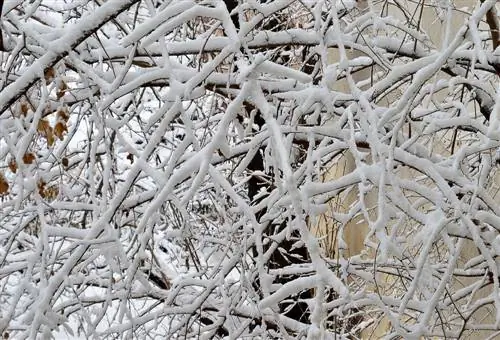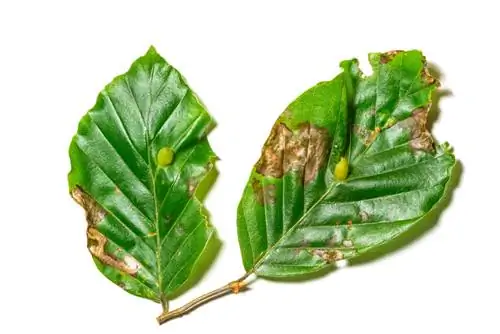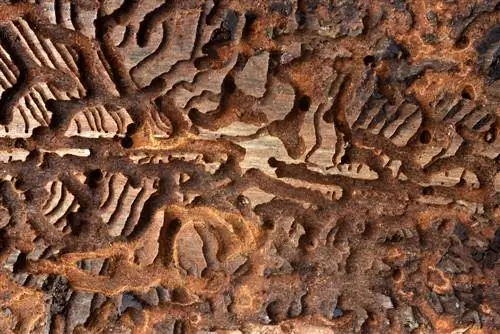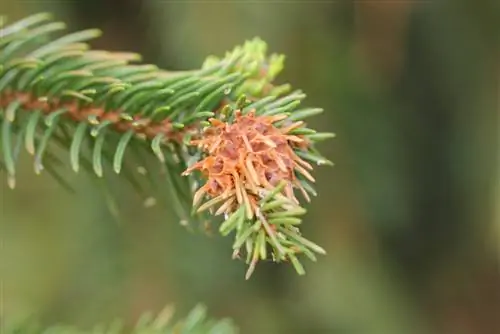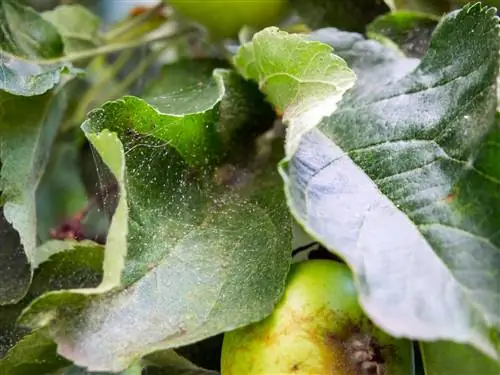- Author admin [email protected].
- Public 2023-12-16 16:46.
- Last modified 2025-06-01 06:02.
Walnuts grow up to 30 meters high, provide us with shade in summer and delight us in autumn with precious fruit - the delicious walnuts. That's all very nice, but unfortunately the walnut tree is a frost-sensitive plant whose leaves and flowers freeze extremely quickly in late frosts. This guide provides you with the most important information about frozen walnut trees.

What to do if a walnut tree is frozen?
A frozen walnut tree shows black leaves and brownish to black flowers. If the leaves are frozen, watch the tree and wait for new growth, support it with fertilizer and sufficient watering. If the flowers are frozen, the chance of harvest is reduced. Protect smaller trees from late frosts with fleece or choose late-growing varieties.
Late frosts cause problems for the walnut
Originally comes from the walnut tree
- from the Eastern Mediterranean,
- from the Balkan Peninsula and
- from Near and Central Asia.
In short: The walnut developed in warm climates.
Walnut trees were already cultivated in Germany in Roman times - but only in the (warmer) southwest. Wild walnut trees were also found (and are found) mainly in the mild winter regions of today's Federal Republic.
Given the origin of the walnut, it is not surprising that it is a frost-sensitive plant. The walnut tree copes particularly poorly with late frosts.
The most dangerous times for walnuts are April, May and June. During these months, walnut trees produce leaves and flowers. During this critical phase, temperatures just below freezing point are enough to cause frost damage.
“Late frosts” after early spring
There is another special type of “late frost”: If spring sets in earlier than usual, i.e. the temperatures rise early, the walnut tree feels stimulated - and sprouts sooner. If a longer cold period suddenly follows, the fresh shoots are exposed to frost without protection and damage is inevitable.
Identifying a frozen walnut tree
It's easy to tell if a walnut tree is frozen. A frost-damaged plant shows signs of change from one day to the next
- black leaves and
- brownish to black flowers.
Saving a frozen walnut tree - how?
Depending on whether the leaves or flowers are frozen, you can help your walnut tree to recover by taking appropriate measures, or you have to rely on the plant's strong self-healing ability.
Frozen Leaves
You are not completely powerless against frozen leaves. But you still have almost no choice but to hope that your walnut tree will sprout again.
Watch the tree. New growth should begin after a few weeks. You can give the plant additional strength with suitable fertilizer (€9.00 on Amazon). Also make sure to give your tree plenty of fluids.
Important: After the late frost, the walnut tree MUST sprout leaves. He needs them to survive. Without leaves, the walnut dies.
Incidentally, it doesn't make sense to cut off frozen leaves. This would only result in open wounds that the tree would need even more strength to heal. It is therefore advisable to leave the disposal of the frozen leaves to the wind.
An exception are refined walnut trees. In this case, you should cut off all frozen leaves after the frost night. However, leave the petioles standing. A few days later, new shoots sprout from the eyes. Then connect the leading drive. After a few more weeks, carefully cut off the frost-damaged shoot.
Frozen Blossoms
Frozen flowers can mean a complete loss of crop. When late frosts occur, the male flowers are always affected (they usually emerge four weeks before their female partners).
In this case, there is only a realistic chance of a harvest in autumn if there is another (he althy) walnut tree nearby.
Prevent damage from late frosts
Large adult walnut trees cannot be protected from late frosts. They are simply too extensive. For smaller trees, however, you can work well with a fleece. At least this measure helps to limit the damage.
Note: By planting a late-growing variety, you reduce the risk factor of “late frost” right from the start.

